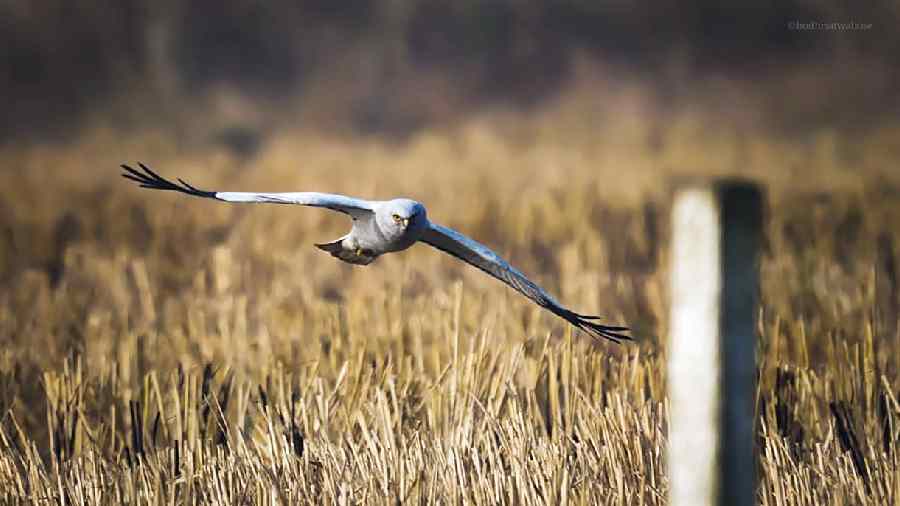An Eurasian Oystercatcher has recently been sighted and photographed in the Sunderbans.
The bird — which is so named because it pries open shellfish and other prey — migrates from the Eurasian region to coastal areas of India in winter, said birdwatchers.
Supratim Mukherjee, who teaches zoology at a college in Hooghly and is an avid birdwatcher, clicked the bird near Lothian Islands, in the southernmost tip of the mangrove islands, on January 28.
The way birds choose the best place to breed, feed, nest and raise their young has brought up interesting details on the audacious journeys they undertake as part of their search for a hospitable habitat.
Every year, migratory birds fly hundreds and thousands of kilometres across continents, driven by one basic mantra — when conditions at one place become unfavourable, it is time to move on to a better place.
In Monday’s edition, The Telegraph carried a story of the rare sighting of a hen harrier, a migratory bird of prey, spotted in a pocket of Hooghly, a district neighbouring Kolkata, by an amateur wildlife photographer.
A veteran birdwatcher who shared the pictures on social media told this newspaper that the hen harrier came from the UK and that they are found in England, Wales, Scotland and Northern Ireland.
Since the report was published, multiple experienced birders got in touch with this newspaper to point out that hen harriers live across northern Europe and swathes of Russia, Siberia, Mongolia and surrounding areas.
“Hen harriers from the UK usually don’t come to India. If they have to migrate, they go towards Africa, which is much closer. Hen harriers spotted in India come from the Eurasian and central Asian regions,” said Sujan Chatterjee, birdwatcher and conservationist.
“In fact, very few birds migrate to India from Europe. Birds always look for the easiest route. A journey from Europe to India will need them to cross half a dozen mountains. European birds cross the Rock of Gibraltar and go to Africa. Most of the migratory birds found in India come from Russia, Siberia, China, Kazakhstan, Mongolia and surrounding areas,” Chatterjee, secretary of the Birdwatchers’ Society, said over the phone from Uttarkahand, where he is on a birdwatching trip in the Garhwal Himalayas.
Migration of birds has multiple patterns. The majority of birds go from northern breeding areas to southern wintering grounds. However, there are exceptions.
“Birds do not have passports. The migratory routes are not cast in stone. But usually, the migratory birds found in India come from Russia and neighbouring areas, while those from western Europe go to Africa,” said Arjan Basu Roy of Nature Mates Nature Club, an NGO that works for wildlife conservation and tracks migratory birds at Santragachhi Jheel.
“A variety of ducks like gadwall, garganey and northern pintail, and waders like curlew and great knot are among migratory birds often spotted around Kolkata in winter. They come from Eurasia and central Asia, where water bodies freeze in winter and food becomes scarce. These birds spend the winter here and around spring, go back across the Himalayas,” said Roy.
How migratory birds navigate the terrains with pinpoint accuracy is a subject of research. Satellite tracking has shown the avians find their way under the sun and by the night stars. A section of researchers has claimed evidence suggested birds can sense magnetic fields in the earth.
Last year, a bar-tailed godwit fitted with a satellite tag flew 13,560km from Alaska to Tasmania in Australia without stopping for food or rest, breaking the record for the longest non-stop migration by a bird.
“The distance covered is equivalent to two-and-a-half trips between London and New York, or approximately one-third of the planet’s full circumference. According to the 5G satellite tag attached to its lower back, the epic journey started on 13 October 2022 and continued for 11 days and one hour without the bird landing once,” says the website of the Guinness World Records.
“The skillset to undertake long journeys are embedded in the system of migratory birds. In Russia, eggs of migratory birds were artificially hatched and the chicks raised by humans. Even those birds managed to fly to Bangladesh during winter and come back to Russia in summer,” said Chatterjee.

